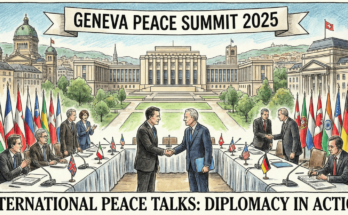Introduction
The Russia-Ukraine war has reached a critical inflection point in November 2025. As diplomatic channels open for peace negotiations, Russian military forces simultaneously escalate their operational intensity with massive drone and missile attacks targeting civilian infrastructure. Military analysts and global observers describe this moment as pivotal, with competing narratives of war crimes allegations and peace proposals defining international discourse. The conflict, entering its fourth year, continues to dominate global news cycles due to its economic implications for energy security, humanitarian consequences affecting millions of displaced persons, and the broader geopolitical tensions between NATO and Russia. Why this story trends worldwide: The potential end to Europe’s largest conflict since World War II captures attention across continents, while simultaneous military escalation creates urgent news cycles and deep analytical coverage from major international news organizations.
Main Body
Russia Escalates Military Operations While Peace Talks Begin
Russian forces have intensified their military campaign across Ukraine with unprecedented scale and coordination. In a single overnight operation spanning November 19, 2025, Russia deployed more than 470 attack drones and 48 ballistic and cruise missiles against Ukrainian targets, according to President Volodymyr Zelensky’s official announcements. These coordinated strikes targeted energy infrastructure, transportation networks, and residential areas across multiple Ukrainian regions including Kharkiv, Kyiv, Ternopil, and Donetsk. At least nine civilians died in Ternopil after nine-storey residential buildings sustained direct hits resulting in significant structural destruction, with rescue teams reporting persons trapped under rubble and ongoing search operations.
The scale of this offensive reflects Russia’s evolving strategy to systematically destroy Ukraine’s electricity, heating, and transport systems as winter approaches. Military experts observe that Russia has perfected its swarm attack tactics, saturating Ukrainian air defenses through simultaneous deployment of hundreds of drones and missiles that overwhelm defensive capabilities. Prior to this November operation, Kyiv endured a five-hour continuous bombardment involving 430 drones and nearly 20 missiles, killing at least eight civilians and damaging critical energy infrastructure.
Alleged War Crimes and Tactics in Pokrovsk
Ukrainian military commanders report that Russian soldiers are engaging in tactics classified as war crimes under international humanitarian law. The commander of the 68th Jaeger Brigade disclosed that Russian forces deliberately disguise themselves as civilians to evade detection and complicate Ukrainian defensive operations in Pokrovsk, a strategically significant city in eastern Ukraine. Military personnel passing as civilians to deceive enemy forces violates the Geneva Conventions and international laws governing armed conflict. Ukrainian commanders state that this tactic fundamentally complicates identification procedures, as soldiers ordinarily only open fire when they identify combatants, not when observing apparent civilians.
The same commander noted that Russian forces lack standardized operational procedures but continue generating logistical complications for Ukrainian forces. This unconventional approach creates asymmetric advantages despite seeming disorganized compared to traditional military structures. The international community, through various human rights organizations and UN bodies, monitors these allegations as potential evidence of systematic violations requiring investigation and documentation for future accountability mechanisms.
U.S. Peace Proposals and Diplomatic Negotiations
Concurrent with military escalation, the United States has pushed diplomatic initiatives to conclude the conflict through negotiated settlement. U.S. Army Secretary Daniel Driscoll and top military generals traveled to Kyiv on November 19 to conduct high-level strategic discussions with President Zelensky and Ukrainian security officials. These visits represent direct engagement by the Trump administration in peace negotiations that reportedly include detailed proposals for conflict resolution.
According to diplomatic sources, U.S. peace proposals reportedly involve compromises from Ukraine including potential territorial concessions in the eastern Donbas region, restrictions on Ukrainian military capabilities including weapons systems and troop strength, and security guarantees negotiated between the United States and Russia. The Telegraph reported that preliminary proposals suggest Ukraine might lease rather than cede control of occupied territories to Russia, with Russian payment of undisclosed rental fees and implementation of Russian legal frameworks in those regions. These proposals remain contested and unconfirmed by official American government channels.
International Diplomatic Tensions and Russian Responses
Britain’s Defense Secretary reported that a Russian spy ship, the Yantar, directed laser weapons at RAF surveillance aircraft operating over international waters near British territory. British officials characterized these actions as hostile provocations and warned Russia of potential military responses. Meanwhile, Poland announced it would withdraw consent for Russia’s last remaining consulate in Gdansk, following railway sabotage near the Ukrainian border that damaged crucial supply routes for humanitarian aid. These incidents demonstrate how the Ukraine conflict extends international tensions across European regions and NATO allied territories.
Kremlin spokesperson Dmitry Peskov dismissed media reports suggesting Russia held secret talks with the Trump administration regarding a 28-point peace plan. Russia’s official position maintains that peace requires Ukrainian recognition of territorial realities, though Russian leadership has not completely rejected diplomatic engagement. Ukraine’s chief of staff Andriy Yermak stated that Kyiv maintains constant contact with U.S. administration representatives and emphasized that negotiations proceed “in a businesslike atmosphere” despite underlying tensions.
Global Implications and Humanitarian Crisis
The intensifying conflict creates humanitarian consequences affecting millions of displaced Ukrainian citizens and refugees across European nations. Energy infrastructure destruction forces civilians into winter conditions without heating or electricity, creating acute health and survival challenges. Economic impacts extend globally through disrupted grain supplies, elevated energy prices affecting developing nations, and military industrial competition among NATO members mobilizing defense production.
Conclusion
The Russia-Ukraine war at the end of November 2025 presents a paradox of simultaneous military escalation and diplomatic engagement. Russian forces conduct operations of unprecedented scale and coordination while international diplomacy attempts to forge peace agreements. The alleged war crimes in Pokrovsk underscore the conflict’s humanitarian toll, while peace proposals suggest potential frameworks for resolution despite fundamental disagreements between combatants. This ongoing tension defines global security architecture and determines energy security for Europe and beyond. As winter approaches and military campaigns intensify, the international community watches whether diplomatic channels prevail over military escalation. What changes do you believe are necessary for sustainable peace in Ukraine to become achievable?




